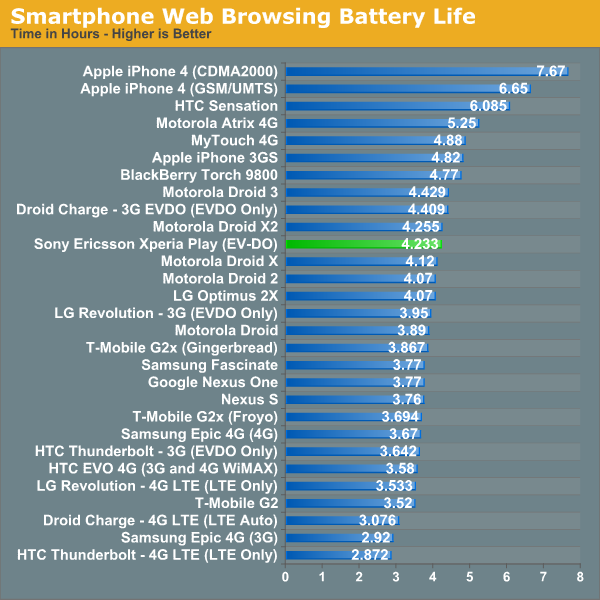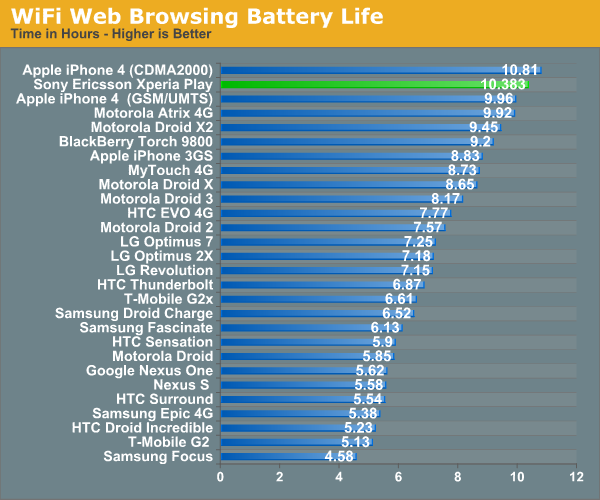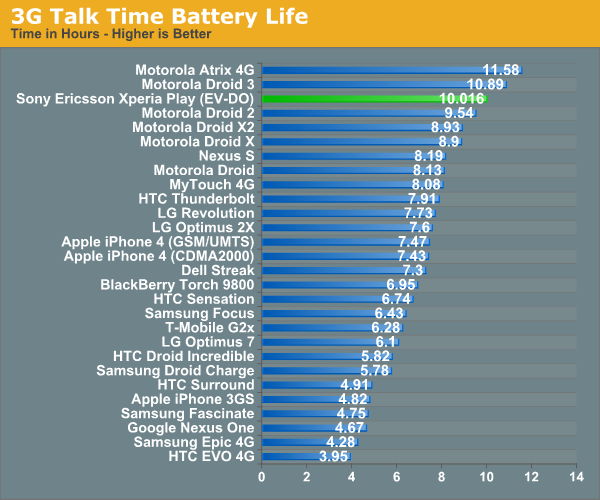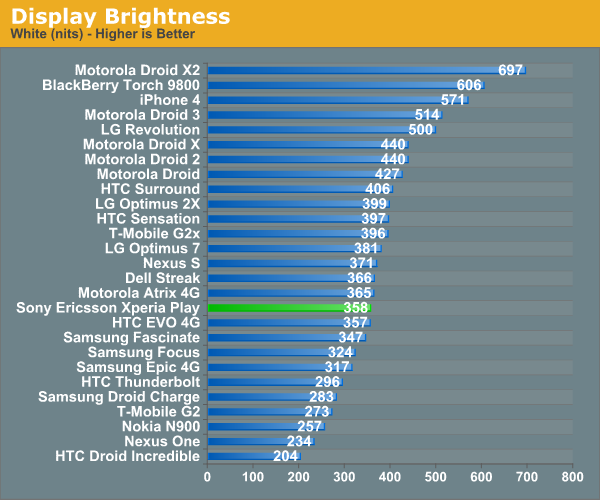The Sony Ericsson Xperia Play: Where Do You Want To Take Your Gaming Today?
by Brian Dipert on August 8, 2011 1:26 PM EST- Posted in
- Smartphones
- Sony
- Android
- Xperia Play
- Mobile
The Xperia Play embeds a single rear-mounted 5.1 Mpixel image sensor alongside a LED flash. There's no dual-sensor rear array, as in the HTC EVO 3D or LG Optimus 3D, although Sony Ericsson included a VGA resolution (640x48 pixel, aka 0.3 Mpixel) front-mounted camera for video chat purposes. The Xperia Play captured passable rear-mount camera snapshots even in low ambient illumination environments, although it doesn't come close to offering the brightest LED supplemental illumination that I've encountered.
Still imaging acceptability was unfortunately coupled with video imaging downsides. For unknown reasons (though I suspect a combination of battery life concerns and CPU performance limitations), the Xperia Play's captured per-frame video resolution is only 800 x 480 pixels (aka widescreen standard definition). I'm profoundly baffled by this shortcoming; my Nexus One contains prior-generation iterations of both the CPU and GPU, yet manages 720p video capture (albeit, admittedly, via a CyanogenMod-delivered hack), as does the silicon-comparable iPhone 4 even in an unjailbroken state. Plus, I personally found the resultant video to be even softer than SD resolution capture would normally deliver, along with a sub-par soundtrack that may be in part a reflection of the non-optimal microphone location.
Anand tested both power consumption and display attributes prior to shipping the Xperia Play to me, so the data that follows comes straight from him. Here's the comparative battery life of the Xperia Play versus other handsets AnandTech has tested, when web browsing both over EV-DO:

and over Wi-Fi:

And here's the 'talk time' battery life comparison:

Anand then measured the Xperia Play's display brightness and contrasted it (pun intended) with other mobile phones:

The default display intensity is a bit dim, perhaps reflecting a decision made by Sony Ericsson to stretch the between-charges usage, but the display acquits itself well versus other gear I've handled in the past once you bump up the setting a notch or few. Its viewing angle is also passable albeit not stellar, and it's much easier to see in daylight than is an OLED alternative. And if you do the math on its atypical 854 x 480 pixel resolution, you'll see that not only does it notably exceed that of the PlayStation Portable (480 x 242 pixels), it also works out to be an exact (to within a few decimal places) 16:9 ratio. This means no cropping, no black bars, and no squishing-or-stretching distortion when watching widescreen movies.
Apologies, by the way, for the lack of a display black level brightness measurement, therefore the associated absence of a contrast metric. Anand had mistakenly thought the Xperia Play had an AMOLED screen (it's a LED-backlit LCD), therefore only took a white level brightness measurement before sending the handset to me, and I don't currently own a colorimeter.










34 Comments
View All Comments
RoninX - Wednesday, August 10, 2011 - link
Maybe they should just release a 3G/4G version of the Vita that makes calls.Then you would get by far the best portable gaming experience without having to carry two devices.
SimKill - Wednesday, August 10, 2011 - link
But then battery life would go to the dogs.etobare - Monday, August 8, 2011 - link
There you make it sound as if xperia play didn't have access to android non-xperia play optimized games... i concur with much of the review but that may lead to confusionMike1111 - Monday, August 8, 2011 - link
A gaming smartphone with fewer, more expensive and worse looking games compared to iOS devices? Why even bother. It's a niche market at best. To have a chance in the mainstream market the successor must have PS Vita-like hardware, graphics and kick-ass games. And should Apple ever decide to make an adequate Bluetooth profile available for (analog) gamepads then the dedicated gaming smartphone market is dead anyway.lowlymarine - Monday, August 8, 2011 - link
I just finished a run of BrowserMark on my Captivate (AT&T Galaxy S) and got a score of over 71,000. Admittedly I'm running at a fairly modest overclock of 1.2 GHz, but unless each one of those 200 MHz are imbued with pure magic, there's no way the likes of the Droid 3 and the Atrix should be doing worse. Similar with Sunspider - my 3193ms result (yes, on 0.9) beats out even the fastest device you've tested. I'm not using Firefox Mobile or something either; this is all with the stock AOSP browser.I'm just curious as to why there's the massive discrepancy in browser performance. My Linpack scores are, while still nearly 3 times what you've got for the SGS (largely attributable to the difference between Gingerbread and Eclair, I'm sure), no where near those of the dual-core powerhouses. I know the second core won't really help them on Sunspider et al., but certainly it shouldn't be hurting them?
Death666Angel - Monday, August 8, 2011 - link
Are you using other/newer kernels and roms? They usually add nice boosts to those benchmarks by either having better drivers, better optimizations or just fewer active programs. :-)Vepsa - Monday, August 8, 2011 - link
I considered getting a Xperia Play, but I decided against since I kinda like having more than 512MB of RAM on my phone. The bulk doesn't bother me and nor does the SoC since I have the same one in my Droid Incredible 2. If the phone had had 1GB of RAM & 2GB+ of app storage I would have probably gotten it. The only thing that will get more games made for them is if more are sold since its an open API.StormyParis - Monday, August 8, 2011 - link
Did someone just receive a new digital camera ? Is there an epidemic of photographic logorrhea I'm not aware of ? Are Ars writers paid a lot more for each picture ? Or is it about the page views ?One could easily cut half the pictures in the article (first page), redo some (you can put 3 phones in a single picture for comparison, yessir....).
This article is giving me a feeling akin to PCmag's infamous "slideshows"
Anand Lal Shimpi - Monday, August 8, 2011 - link
Fixed :)We have no internal mandates for picture or page count, sometimes it's easier just to string a bunch of images together rather than toss them in a gallery but I've done the latter here at your request :)
Take care,
Anand
StormyParis - Monday, August 8, 2011 - link
Thanks. Am I the only one bothered when there are so many pics in an article ? because, frankly, the numerous screenshots and charts on the following pages also bother me. With Anandtech's already narrow, heavily paginated format, there's lots of scrolling involved already... I find more than 1 pic/page a pain, except when the pics are *really* needed... which they are not, for example, to report a *one-number* test result. It gets even worse when reading the article on my phone or tablet.Personally, I simply jumped to the conclusion after a few pages. I find the galleries you put in the first coupl of pages the best trade off: really motivated readers can see all the pictures, the rest of us can read the article without kilometers of scrolling. <ripoff source="Arrested Development ">It's a nice way to satisfy the "buy" crowd and the "curious" crowd, and we're all buy/curious </ripoff>